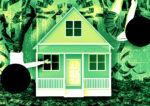Homebuying hasn’t been this unaffordable in decades. That’s prompting more families to turn to renting, powering a boom in the single-family rental business.
Some 93,000 homes built as single-family rentals were completed last year, according to the Wall Street Journal, citing estimates from housing consulting firm John Burns Research and Consulting. That represents a 39 percent increase from the previous year and a record for the sector, according to John Burns.
This year will be another big one, the firm predicts, before construction starts to taper off in 2025. Approximately 99,000 rental homes are under construction this year, despite tighter lending conditions.
“This isn’t going away,” developer Richard Ross told the Journal.
Rent growth is not nearly as fast as it was at the start of the pandemic, but house rents still trend above apartment rents. Occupancy in single-family rentals has held up better than in multifamily buildings.
Just as importantly for the single-family rental sector, the cost of homeownership has outpaced the expense of renting. In March, the average monthly mortgage payment was 38 percent more than the average monthly apartment rent, according to CBRE.
Read more



Single-family rentals appeal to people from all walks of life. Rental houses come in a wide range of shapes and sizes and are options for those who have outgrown apartment living, seeking a single-family neighborhood, or transitioning from ownership. An executive of Chicago-based asset manager Heitman recently said the firm expects “a growing number of older millennials and retirees to rent.”
Besides market forces, the biggest challenge facing single-family rental companies is scrutiny from Congress, where some members claim — without much evidence — that Wall Street’s push into the housing market is reducing housing affordability for the masses. Builders of single-family rentals avoid the criticism facing private equity firms that purchase and convert houses into rentals, and can advance a narrative that they are helping to address the housing shortage.
